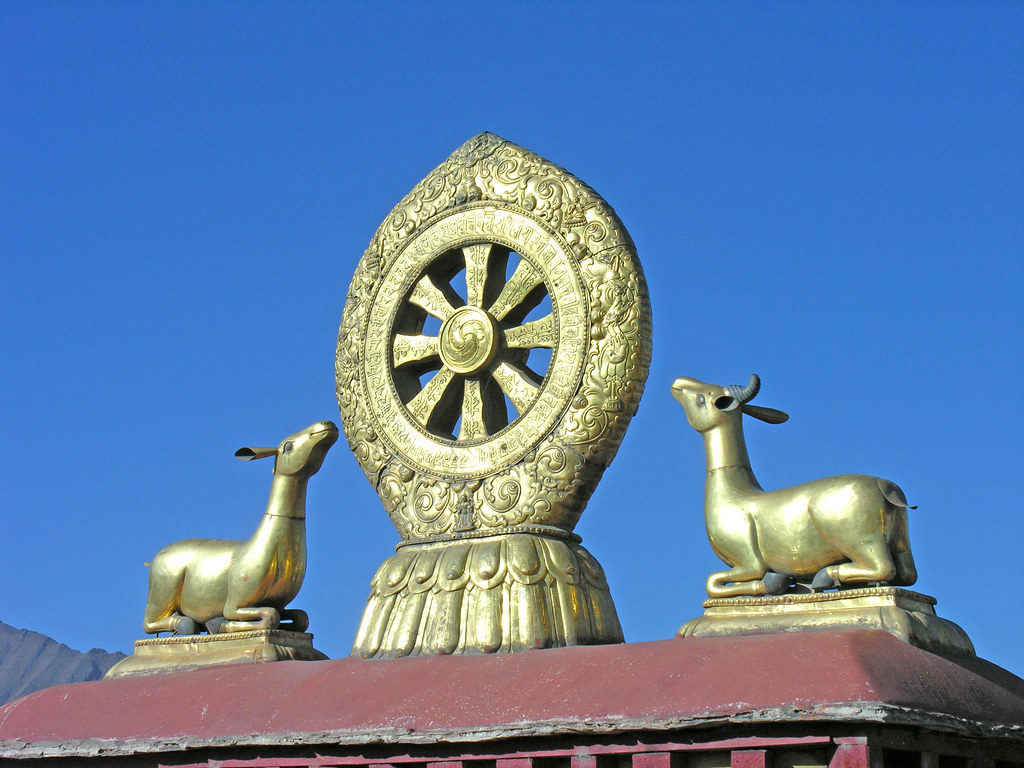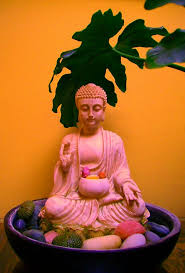Buddhism art and imagery are rich with symbolism. In particular, specific hand gestures or mudras are found throughout Buddhist art and are used by individuals during meditation and other Buddhist rituals.
Buddhist deities and art includes images of buddhas and bodhisattvas, “enlightened beings” in various positions, with important Buddhist symbols including mudras. Certain mudras are quite common. They appear in statues, pictures, and prints. Some mudras usually appear in combination using both hands while others may appear alone with just one hand posed. Although there are several mudras throughout Buddhist art, there are five particular mudras that are typically symbolized in images of the Buddha. The symbolism in the poses is specific and complex. A summary of these five mudras is below.
Dharmachakra mudra

The Dharmachakra mudra refers to the “Wheel of Dharma” in Sanskrit. This pose symbolizes Buddha’s first teaching about the Enlightenment in Deer Park at Sarnath. The mudra is of both hands posed with thumb and index finger touching in the shape of a circle. The circle symbolizes the Wheel of Dharma, the synthesis of method and wisdom. The other three fingers of each hand, pointing downward each represent a part of Buddhist thought as well.
Bhumisparsha mudra
The Bhumisparsha mudra means “touching the earth”, and is known is Buddhist thought as the “earth witness”. The right arm is extended downward with the five fingers appearing to point toward the earth. The story behind this mudra indicates that the Buddha is asking the earth goddess, Sthavara, to witness his achievement of enlightenment. Interestingly, the left hand is engaged in a separate mudra representing the understanding of conventional and ultimate truths. In this gesture, the left hand is posed in the Buddha’s lap in a common meditation pose.
Varada mudra
The mudra that demonstrates compassion for others and the act of giving to others is known as the Varada mudra. The left hand is typically used for this pose-the arm is comfortably hanging down the Buddha’s side with an open palm facing forward and fingers pointing skyward.
Each finger stand for one of the “five perfections”:
- Generosity
- Morality
- Patience
- Effort
- Meditative Concentration
Dhyana mudra
The Dhyana mudra involves posing either one or both hands in the same gesture. When only one hand is used to symbolize Dhyana, the left one is in the lap with the right one posed in a different mudra. This gesture signifies the female concept of wisdom. Items of rituals such as a book or bowl may also be seen in the left hand. The two-handed version of this pose involves both hands held even with the stomach or on the thighs, the right hand above the left. With both palms open and facing skyward, the fingers are extended. When the two thumbs are touching one another at the tips, the mystic triangle is formed. There is disagreement in Buddhist doctrine as to what this gesture may symbolize, but most believe the Buddha is signifying the mystic fire that envelopes “impurities”. Another popular interpretation of the mystic triangle is that it is the representation of the Three Jewels of Buddhism-the Buddha, the Good Law, and the Sangha.
Abhaya mudra

In Sanskrit meaning “fearlessness”, the Abhaya mudra represents peace, protection, and dissipation of fear. With elbow bent on the right arm, the right hand is held at shoulder height, with the open palm facing out, and the fingers upright, almost as if in greeting someone hello’.
Individuals in worship use mudras during performance of Buddhist forms of meditation, visualizations, and mantras. During such rituals, individuals assume familiar poses and positions of the deities in hopes of transforming himself in becoming more like the deities. Holding the special poses or mudras is believed to encourage concentration. Mudras definitely hold special significance in Buddhist imagery and art and as poses modeled by followers of Buddhism.





